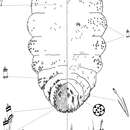Description
(
Anglèis
)
fornì da Zookeys
Field characters: All pine-feeding Chionaspis discussed here, including Chionaspis heterophyllae and Chionaspis pinifoliae, are indistinguishable by eye in the field. The adult female for all species possesses a white oystershell-shaped and slightly convex cover, with the amount of posterior expansion varying according to the diameter of host needles. Body elongate, color varying from yellow when immature to reddish brownish in specimens containing eggs, with lateral protrusion on the anterior abdominal segments. Found on needles.
Slide-mounted adult female (Figure 1), broadest at metathorax, with thoracic segments lobed laterally, prothorax becoming narrower towards the anterior, ending with a pointed head, giving the appearance of a reduced, shrunken head; length of holotype 1.33 mm, range (n= 6) 0.85 – 1.33 mm; maximum width of holotype: 0.63 mm; range (n=6) 0.45 – 0.66 mm.
Pygidium: Lobes. Posterior margin with 3 pairs of definite lobes (L1, L2 and L3), fourth pair (L4) appearing as series of low, sclerotized points; paraphyses absent. L1 separated by space 0.31 – 0.6 (0.4) times width of lobes, with a heavily sclerotized yoke, lateral and medial margins of L1 diverging from base to apex, medial margin convex with notches towards apex, lateral margin entire; L2 bilobed, smaller than L1, medial lobule larger than lateral, sometimes with notches, lateral lobule minutely notched; L3 bilobed, lateral lobule shorter than medial lobule, with minute notches, in some specimens appearing membranous or obsolete. Gland spines. Gland spine formula varying from 1-1-1 to 2-2-2 (2-2-2) (microduct formula varying from 2-2-2 to 3-3-4 (3-2-2)), gland spines projecting beyond L1; with 1 – 2 (2) gland spines on abdominal segment 5; without gland spines between L1. Ducts. Large macroducts in submedian area of segments 5 and 6 (with 5 – 10 (8) on segment 5 and 4 – 7 (5) on segment 6); in submarginal areas of segment 5 (with 8 – 10 (9)); marginal area of segments 5 to 7 (with 1 on segment 7, 2 on segment 6, 2 – 3 (2) on segment 5); absent on segment 8. Largest macroduct on segment 7 (between L1 and L2) 15 – 17.5 (17.5) μm long. Pygidial microducts always on venter in submarginal areas of segment 5 to 7, with 2 – 4 (2) ducts on segment 5, 1 – 3 (2) ducts on segment 6 and 1 ducts on segment 7 ; pygidial microduct absent from dorsum. Pores. Perivulvar pores with 5 loculi, in 5 groups, 1 median with 9-15 (13) pores, 2 anterolateral with 19 – 33 (23) pores, 2 posterolateral with 19 – 33 (25) pores. Anal opening. Located 6.8 – 10.2 (8.4) times length of anal opening from base of median lobes, diameter 15 – 20 (17.5) μm.
- licensa
- cc-by-3.0
- drit d'autor
- Isabelle M. Vea, Rodger A. Gwiazdowski, Benjamin B. Normark
- sitassion bibliogràfica
- Vea I, Gwiazdowski R, Normark B (2013) Corroborating molecular species discovery: Four new pine-feeding species of Chionaspis (Hemiptera, Diaspididae) ZooKeys 270: 37–58
- autor
- Isabelle M. Vea
- autor
- Rodger A. Gwiazdowski
- autor
- Benjamin B. Normark

